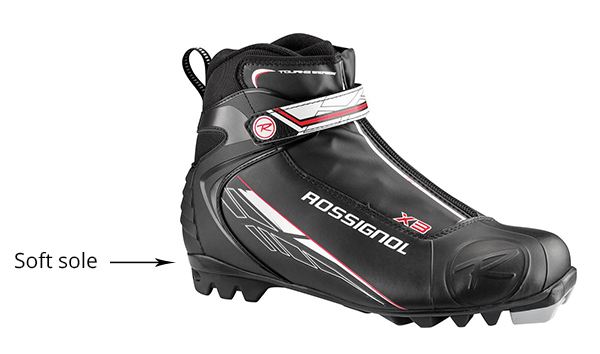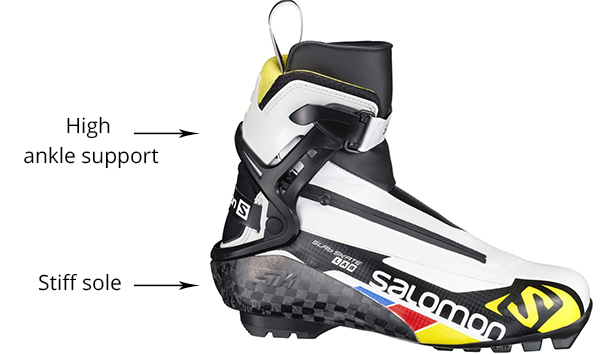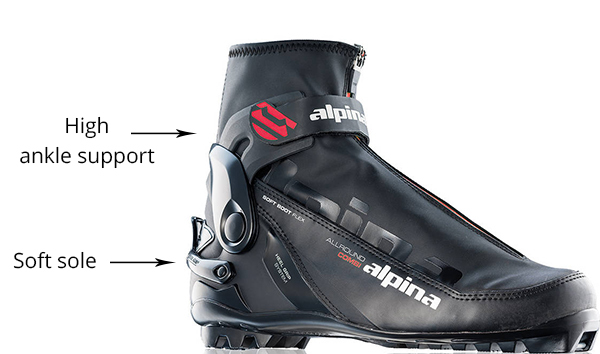Guide to Purchasing Cross Country Ski Boots

Choosing the right cross-country boots is crucial for an enjoyable skiing experience, regardless of the style you are engaged in. To assist you in making a well-informed decision, we have put together some critical pointers.
Overview
Cross Country Ski Boots Sizing: Determining Your Ideal Size
Cross country boots need to fit snugly to keep your heels secure while skiing. The goal is to avoid a fit that is excessively tight or overly loose. There should be sufficient space in the toe area to wiggle your toes slightly to prevent injury from compression. If the boots are excessively tight, it could affect your balance and circulation. Typically, people wear thicker socks with their cross-country ski boots; thus, the boots should be roughly half to a full size larger than your running shoes to accommodate this.
Make sure to adhere to the sizing guide for the particular boot you are considering when shopping for cross country boots at SkatePro. This assists you in comparing your foot length with the specific boots of interest. In our guides, we often offer advice based on customer feedback.
Choosing Cross Country Skis Based on Usage: Recreational vs Competitive Skiing
When purchasing cross-country ski boots, it is imperative to match your choice with the specific purpose you have in mind. The design of cross-country boots differs according to their intended use, whether for leisurely excursions or competitive events such as Sweden's renowned Vasaloppet race.
Recreational Cross Country Boots
For recreational purposes, comfort and ease of use are paramount. Recreational cross-country boots prioritise keeping your feet warm and comfortable with a relaxed fit suitable for longer outings. These attributes are also desirable for beginners or children who desire an enjoyable time in the snow.
Competitive Cross Country Boots
Boots designed for performance have a tighter and more precise fit. This snug fit maximises power transfer from your legs to your skis. These boots feature lightweight materials such as carbon for minimal weight, which enhances speed and agility. Competitive cross-country skis focus less on comfort and are naturally intended for advanced skiers.
Different Varieties of Cross Country Ski Boots
There are four different varieties of cross-country ski boots to choose from, depending on the style of skiing you plan to engage in. Additionally, we describe a fifth type, which is made for roller skiing.
Classic Cross Country Ski Boots - Soft Soles

Classic style cross-country boots possess a soft and flexible sole, essential for executing classic cross-country strides via forefoot flexion.
Both novice and seasoned skiers will find suitable boots in this category, assuming they partake in classic cross-country skiing. Beginners should focus on warmth by selecting boots with a thicker lining that also provide heel and ankle support. These boots are ideal for the annual winter holiday or for those new to the Vasaloppet competition.
Classic cross-country boots for more seasoned skiers are generally lighter than beginner versions, featuring a thinner lining to reduce weight and prevent overheating during use. They also include a stiffer heel counter to further enhance power transfer.
Explore our range of Classic Cross Country Ski Boots.
Skate Ski Boots - Enhanced Ankle Support and Rigid Soles

Skate ski boots are crafted differently from classic cross-country ski boots due to the distinct nature of skate skiing. The skating action exerts considerable pressure on the ankles through lateral movements; therefore, skate boots come with a stiffer and taller ankle brace, made from materials like plastic or carbon for enhanced support.
Unlike classic skis, skate boots are equipped with rigid soles, allowing power in each stride by enabling the use of the entire sole, not just the forefoot.
Browse our selection of Skate Ski Boots.
Cross Country Combi Boots - Flexible Soles Combined with High Ankle Support

If you partake in both skate and classic skiing and desire a single pair of boots, or need added ankle support for classic skiing, consider combi boots.
Combi boots integrate features from both classic and skate boots, providing ample ankle support for skating while maintaining ankle stability during kicks. At the same time, the flexible sole permits the foot roll needed for classic push-offs, a motion difficult to achieve in skate boots.
Find our collection of combi boots in the Skate Ski Boots and Classic Cross Country Ski Boots sections.
Backcountry Ski Boots - Durable and Weatherproof
Designed for backcountry expeditions, these boots include numerous features to optimise your wilderness outings. Resembling traditional hiking boots, backcountry ski boots are crafted to keep your feet warm and comfortable, fundamental for those embarking on extended treks. High cuffs support the ankles and prevent snow ingress.
In summary, backcountry adventures necessitate boots specifically designed for the purpose, ensuring durability, comfort, and waterproofing.
Explore our offerings of Backcountry Ski Boots.
Rollerski Boots - Focus on Ventilation
While many individuals use cross-country boots during the off-season for rollerskiing, some find feet become too warm. If this is the case, consider investing in summer roller ski boots for NNN bindings (NIS). These boots are lighter and offer better ventilation compared to traditional cross-country ski boots.
Remember that using cross country boots for rollerskiing can speed up wear and tear, particularly around the zipper. To prolong their lifespan, ensure they are cleaned of dirt and stored in a dry environment when not in use.
Check out our selection of Roller Ski Boots.
Compatibility of Cross Country Ski Boots and Bindings
Verifying that your cross country boots and bindings are compatible is essential prior to committing to a purchase. Harmonising cross country boots with bindings requires matching boot soles to the correct bindings.
The chart below provides two ways to assess your options. Identify your cross country boots to see which types of bindings they accommodate, or identify your ski bindings to determine which boots are suitable. This method simplifies finding boots that are compatible with your bindings.
```html
Compatibility Chart for Cross Country Boots and Bindings
| NNN Bindings | Prolink Bindings | Turnamic Bindings | SNS Profil Bindings (Classic) | SNS Pilot Bindings (Skate) | NNN BC Bindings | |
|---|---|---|---|---|---|---|
| Alpina Boots | x | x | x | |||
| Atomic Prolink Boots | x | x | x | |||
| Atomic SNS Pilot Boots (Skate) | x | |||||
| Atomic SNS Profil Boots (Classic) | x | |||||
| Fischer Boots | x | x | x | |||
| Madshus Boots | x | x | x | |||
| Rossignol Boots | x | x | x | |||
| Salomon Prolink Boots | x | x | x | |||
| Salomon SNS Pilot Boots (Skate) | x | |||||
| Salomon SNS Profil Boots (Classic) | x | |||||
| Alpina, Fischer or Madshus NNN BC Boots | x |
More insights on the compatibility of bindings for cross country boots and roller skis are available in our detailed guide Compatibility of Bindings for Cross Country and Roller Skis.
